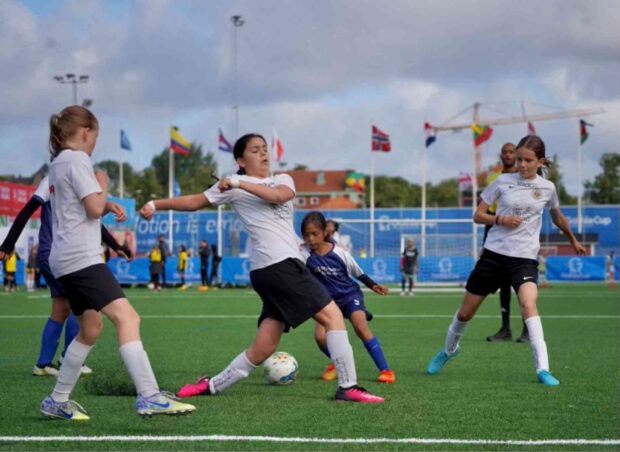Away from World Cup spotlight, the future of PH football takes form

Makati FC’s Renzel Grace Gella (third from left) battles three bigger girls from Sweden. —CONTRIBUTED PHOTO
The Filipinas talked about opening doors and breaking glass ceilings.
More than 17,000 kilometers from where the Philippine women’s football team is trying to reinforce that mission with a competitive show in its historic stint in the Fifa (International Association Football Federation) Women’s World Cup, a Filipino delegation is taking heed.
Article continues after this advertisementMakati Football Club (MFC) sent age-group teams to the Gothia Cup in Sweden, one of the biggest youth football tournaments in the world and its Girls 14 team finished with a silver, giving a glimpse of the sport’s future in the country.
“I am happy to bring home this achievement to Cebu and hopefully, this will inspire and open doors to other young girls in my province,” said Yona Dela Calzada, a midfielder in that squad that lost to a home club in a final that needed penalties to decide.
“It’s an amazing experience playing for Makati FC here,” she added.
Article continues after this advertisementAnd all that happened against the backdrop of the Filipinas’ campaign in New Zealand, where they are the first Philippine team to reach football’s biggest stage—men or women.
“I just want [myself] and the rest of the team to be attainable and reachable for little girls back home,” Filipinas cocaptain Hali Long said in a pre-event press conference in New Zealand.
The Filipinas had yet to step on a World Cup pitch for the first time when Long spoke of the team’s mission, but they had already gotten a taste of playing with the big girls in a friendly against powerhouse Sweden before the tournament opener.
Bigger opponents
Meanwhile, in Sweden, the MFC girls were competing against big girls, literally.
Renzel Grace Gella, a nine-year-old fireball playing in the Girls’ 11 category, competed several times against girls almost twice her size and finished the tournament with five goals, including two against a home squad.
“I believe that when you play, your size doesn’t matter as long as you always give your best,” Gella told the Inquirer in a message written in her native Ilonggo. “I’m happy that I was able to come here and compete.”
Gella is one of the scholars of MFC, one of seven from Negros that the academy trains regularly. The other scholars include two from Cebu, two from Bohol and others from Davao, Olongapo and Pampanga.
The target is that from their ranks and from the ranks of growing MFC enrollees, the future of the sport will emerge.
Inspired by Filipinas
“The Philippines being in the World Cup is mostly the reason why there are so many girls looking to play football,” said MFC president Selu Lozano. “We want to build these homegrown eight-to-15-year-olds to have the international exposure as early as now and get them to be world-class athletes in the next five to 10 years.”
MFC is also giving that same experience to province-based coaches.
“Trusting me to be included in this trip has been a great experience,” said coach Jonilda Delim-Willaranda, of the Pontevedra Futboleros program based in Negros Occidental. “It widens my ambition to work harder and do better trainings and fuels my desire to produce more potential players from the province.”
“I get goosebumps here. Our kids are playing so well,” said former U19 national coach Dan Padernal, who hails from Sta. Barbara, Iloilo and whose squad in Sweden is reinforced by footballers from Indonesia and Thailand. “This helps our homegrown athletes develop more and increases their level of competitiveness.”
The Gothia Cup ended on Saturday, a day after the Philippines finally made its World Cup debut, a 2-0 defeat to Switzerland that was largely a win for the sport in the country—if only for the way it turned a dream into a realistic goal for the likes of Gella and Dela Calzada. INQ